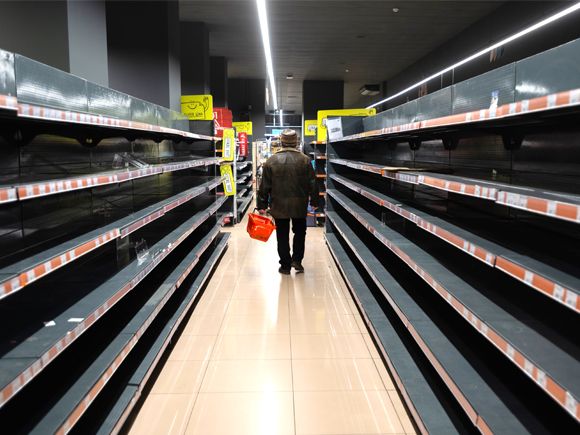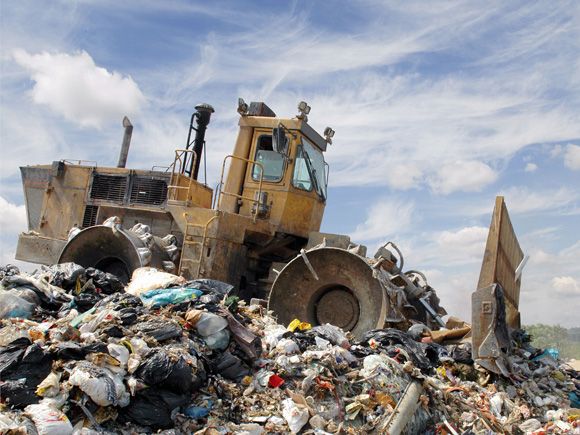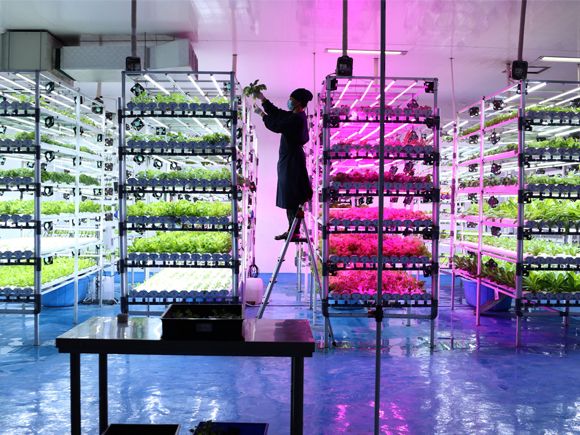The war on Ukraine has weaponised global food supply. In blockading ports and destroying infrastructure, Russia is severing ties between acutely food insecure populations and the Ukrainian wheat and cooking oil on which they depend. Putin’s refusal to end the blockade unless sanctions are lifted dispels any doubt that global food security is a deliberate target. The war is not the sole cause of rocketing food prices, nor of food shortages. But it has added fuel to an already raging fire, following two years of economic upheaval and a worsening cost-of-living crisis.
The latest food price spike is one of a series that have taken place over the past 15 years:
- In 2007-2008, amid the financial crisis;
- in 2010-2011 (which helped trigger the Arab Spring in North Africa and the Middle East); and
- in 2020, when Covid-19 hit.
These episodes underline how vulnerable our globalised food system is in times of turmoil. They are not momentary blips, but symptoms of a system that is fragile and dysfunctional, and that is failing to deliver food security for all. With extreme weather events wreaking havoc as the climate warms, our hopes of combatting global hunger and malnutrition depend on immediate and fundamental change.
The term “food security” is used in different, often contradictory, ways. The simplest is having access to sufficient calories to avoid hunger and starvation. Another common meaning is building a supply base that adjusts to meet demand, whatever the consequences for the nutritional value of our food and the impact on the environment. Finally, the term is used to refer to a state where everyone, everywhere has reliable access to enough nutritious, affordable and culturally appropriate food, including in times of hardship or emergency. On this view, food security is an outcome not simply of sufficient production, but of the effective workings of a global system—farmers, supply chains, infrastructure, policies and finance—to ensure the fair and sustainable production and distribution of our food.
Yet today’s global food system is failing to deliver security by any definition. While the world’s food production has increased year-on-year for the past 60 years—to 2.7bn tonnes of cereals alone in 2018—the number of food-insecure people has been rising for several years, while the gender gap in food insecurity is widening.
Harming health and planet
Poor diets are currently responsible for 20 per cent of deaths globally—more than any other single cause—and lie behind nearly half of all deaths in children under five. The problem is not a lack of food at the global level, but its inequitable distribution and affordability. An estimated three billion people cannot afford enough healthy food, a function both of the high costs of a nutritious diet as well as pervasive income inequality. For others, the diversion of crop calories to produce cheap meat and processed goods has encouraged diets that are high in fat, salt and sugar but low in nutritional value. We see the impact in rates of obesity, cardiovascular disease and type 2 diabetes.
On top of this, the decades-long drive to produce more and more food has come at huge environmental cost. The world is now largely dependent on the production of a small number of crops—wheat, maize, rice, barley, soybean, palm oil, sugar and potatoes—in a small number of regions. As demand for these staples has risen, so too has the use of chemical inputs to maximise yields. These fertilisers, pesticides and herbicides degrade soils and find their way into water systems, damaging marine ecosystems.
At the same time, rainforest, savannah and peatland have been razed to make space for cropland and pasture, meaning animal habitats and food sources are lost and species face extinction. The space available for nature is shrinking: today, half of all habitable land is taken up by crop production or the rearing of livestock. Food production, and especially livestock farming, contributes about a third of all human-driven greenhouse gas emissions.
Our current patterns of production and consumption are undermining reliable access to affordable food, both today and for future generations. So what are the structural causes behind our new age of food insecurity and what can be done to build something more resilient?
One of the most striking—and dangerous—characteristics of our current food system is the way globalisation and liberalised trade have spurred increasing specialisation in international food supply chains, concentrating different sectors of the industry among a handful of producers and encouraging more intensive production. The pursuit of ever-cheaper food and ever-more intensive farming has trapped us in an unsustainable situation. Cheap staple crops have contributed to cheap processed products and, in high-income economies, to cheap meat. These low prices have stimulated demand further. Neither producers of more nutritious foods—fruit, vegetables, nuts and seeds, legumes such as peas and beans—nor of organic goods have benefitted from the same forces. The cost of these goods is thus relatively or prohibitively high. When household budgets are tight, these foods are sacrificed in favour of cheaper, more readily available calories.
The risk of disruption
With the global food system increasingly run on these international supply chains, we have made ourselves vulnerable. Climate change is multiplying the risk of harvest failures, large-scale infrastructural damage, mass migration and conflict, creating the conditions for high and volatile food prices and food shortages. At the same time, the geopolitical landscape is shifting and trust in multilateralism is waning. Should the international community fracture further, the reliability and long-term viability of food supply chains are sure to suffer.
The war in Ukraine and the Covid-19 pandemic have both disrupted globally-interconnected food supply chains and showed the upheaval that can result. The virus created profound logistical challenges, contributing to a global cost-of-living crisis that was driving up levels of food poverty even before Russia’s war.
Following that invasion, food prices have skyrocketed, the result not only of a sudden loss of exports from Russia and Ukraine but of energy price hikes leading to dramatic increases in the cost of fertiliser. The world is not going to run out of food today, even though Ukraine and Russia are both major global suppliers of wheat and sunflower oil. But potential shortfalls in availability drive up prices as panic buying ensues. The disruption so far has been enough to shake global markets to the extent that households around the world are feeling the crunch, and the number of people in food insecurity is set to soar.
Poor diets cause nearly half of all deaths in children under five globally
Looking ahead, prices may rise further if high fertiliser prices reduce planting, and other major wheat-producing regions are unable to fill the shortfall, or if there is a significant harvest failure in another breadbasket region. In the longer term, shifting geopolitical alliances may force changes in global trade networks that keep prices higher for years to come.
System change
It can be tempting to see something as sprawling as the global food system as beyond the reach of government—yet global food insecurity is the product of policy decisions. The virtual exclusion of agriculture from climate policy has spared the sector from the pressure to transition to more sustainable practices: indeed, the pressure has largely been in the opposite direction. Governments have long sought to boost agricultural productivity, both as an engine of economic growth and as a way to push down the cost of food. Vast amounts of public money have been channelled into subsidies, infrastructure and research and development to turbocharge food production.
Policymakers are beginning to wake up to the fragilities of our current system and the need to transform how we produce, trade and consume our food. Food and agriculture are rising up the agenda at international climate talks and are a growing focus of research by the Intergovernmental Panel on Climate Change. Last year saw the UN convene a Food Systems Summit. The worsening food crisis stemming from the pandemic and fallout from the war will be a core issue for discussion among the G7 heads of state this year.
There are many ways we could improve food systems, but specific strategies are often contested by those with different visions for the future. Some press for further production in global breadbasket regions. Yet an alternative to today’s intensive farming is needed. The ecosystems we are degrading through intensive farming and the mass conversion of land are vital to our planet’s natural defences and sustaining the quality of water, air and soil. These ecosystems should be helping to absorb carbon emissions, regulating the surface temperature of the earth and protecting against the destruction wrought by weather and climate extremes. Instead, we are weakening nature’s resilience to diseases and invasive species, accelerating climate change, increasing the likelihood of climate damage to crops and limiting the capacity of the soil to deliver healthy, reliable harvests.
That’s why others are in search of alternative production methods that reduce the need for chemical, energy, land and water inputs. Methods such as vertical farming, hydroponics, aquaponics and even lab-cultured meat (see box) have a role in a more sustainable system, but significant technical, financial and cultural hurdles will need to be overcome if they are to be taken to scale. Agroecological approaches to farming—which minimise the use of chemical inputs in favour of crop rotation and diversification, natural fertilisers and natural pest control—hold the greatest promise for more nature-friendly production, but require vastly more investment than they receive today.
Dead meat
And then there are those pressing for wholesale changes in demand to shift not only how we produce but what we produce, and in what quantities. Changes to farming methods will not be enough to break the vicious cycle of poor diets and environmental harm; only radically lowering the demand for meat in high-income countries can do that. Animal products are an important source of high-quality protein and nutrients but currently they represent a huge drain on global resources. One-third of all grain is destined for use as animal feed. If the global population and demand for meat rise as forecast, agricultural production will need to increase by 50 per cent over the next 30 years.
A shift to lower-meat diets in high-consuming countries could reduce the need for grain and oilseed production. Moving away from red and processed meat in particular would lower the climate impact of the food sector, free up land for use in less-intensive production and for biodiversity conservation, ease upward pressure on food prices and also deliver benefits for human health.
Reducing the amount of food that is lost or wasted is also a critical step. Just under a quarter of all calories produced end up being lost or thrown away, also wasting the vast amounts of land, water, fertiliser and energy used in their production. Better storage infrastructure on farms and along supply chains, better refrigeration in more homes, improved understanding of “best before” dates, and the redistribution of unsold items from supermarkets to food banks could all drive down food waste. This would also bring a host of other benefits—among them, greater supply of emergency food for the most vulnerable and reduced emissions from discarded food in landfill.
In the market
Changes to the way food is consumed will not be brought about by individual behaviour alone. Structural changes to food markets are needed. Government subsidies in large producing countries have played a key role in shaping both agricultural production and consumer demand. They have tended to support a small number of foodstuffs—meat, dairy products, rice, maize and other staple grains such as wheat. This has enabled producers to keep their costs down, and so kept consumer prices low relative to other goods. With abundant supply at affordable prices, this food has come to dominate diets around the world. Fruit and vegetables, on the other hand, remain underproduced and overpriced: we grow only a third of the amount needed were everyone to eat their five a day and, partly as a result, fresh and high-quality fruit and vegetables are prohibitively expensive for many.
Redirecting subsidies to fruit and vegetables; nutrient-dense, protein-rich leguminous crops like lentils; or alternative cereals like buckwheat and sorghum would boost supply and lower prices, and so encourage a change in our eating habits.
If demand for meat rises as forecast, agricultural production will need to increase 50 per cent over the next 30 years
Recent modelling has shown that structural change to markets of this kind, coupled with reduction in food waste and other measures, could allow us to feed people healthier and cheaper diets while significantly reducing environmental harm. The political feasibility of implementing such changes depends on whether we, as citizens, are willing to embrace changes to the way we consume.
Successful strategies to transform the food system will vary from one country to the next. In many developing economies, food production remains fragmented, with small-scale and family farms accounting for most domestic production. Here, improvements to the production base itself—for example, bringing small-scale producers together through co-operatives to leverage a greater market share, negotiate better prices and gain greater access to training, finance and insurance—will be central. These steps can help boost productivity and build the resilience of farmers in the face of climate extremes, increasing competition for land and water resources, and displacement by industrial agribusiness.
With the right investment, these farmers can be supported to continue working their land sustainably and profitably, and to grow diverse crops that are well suited to the local environment, meet local tastes and improve the availability of nutritious and varied foods on local, regional and international markets.
The threat of politics
It is possible to imagine a better food system, but a fundamental change in the politics of food is needed. Farming lobbies hold enormous sway in major food-producing countries, leaving politicians reluctant to shift support away from large-scale intensive agriculture, while advising populations on what they should and should not eat is regarded by many in liberal societies as the worst kind of “nanny statism.”
Political commitment to tackling the environmental harms of industrial agriculture has thus been weak, and worsening diets and diet-related health have been blamed on poor individual choices. Food poverty continues to be seen by many as a symptom of poor household planning and financial management, rather than the inevitable outcome of socioeconomic inequality and inadequate social support. Decisive action to address the failings of our global food system is needed, as is a departure from the common framing of food security in terms of meeting consumer demand.
Decisionmakers must recognise that volatility and disruption are the new normal and extreme weather events are ever-more frequent and severe. The impacts of climate change are likely to bring greater social unrest, frequent conflict, deepening poverty, worsening health, rising mortality rates and economic instability. On top of this, the future ability of the international system to keep trade moving in times of crisis is now, in the wake of Russia’s invasion of Ukraine, highly uncertain. Against this backdrop, sudden disruptions to supply chains and extreme spikes in food prices will be regular events. Building the capacity to cope is therefore critical.
The primary role of governments is to ensure the security of their populations. Food security is central to this. Governments have a duty to ensure that everyone everywhere has access to adequate, affordable and nutritious food. This means putting in place social safety nets to guarantee that economic hardship does not lead to households choosing between heating or eating. But it also means addressing head-on those aspects of the food system that threaten the basic human right to a healthy diet.
As governments scramble to manage the global cost-of-living crisis, there will be a strong temptation to favour short-term policy responses over long-term system transformation. We are seeing this already in response to high food and fertiliser prices, with policymakers in the EU bowing to pressure from farming groups to ease environmental protections and allow for a temporary expansion of European crop production on land previously reserved for nature.
But reactive policymaking of this kind serves to entrench existing weaknesses in our food system that are failing the most vulnerable. To overcome pervasive and growing food insecurity, policymakers must maintain their focus on the long game, however politically challenging that may be.

















